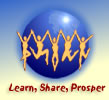Seven Major Mistakes to Avoid in
Your Next Electronic Slide Presentation
by Adele Sommers
Tired of boring business presentations? You're in good company! Many people don't know what's required to create a truly effective electronic slide show, and are equally turned off by viewing the ones that other people produce.
What are some of the most common complaints you hear about the presentations you typically attend, whether for business, technical, scientific, social, philanthropic, or academic purposes? How about...
 "They're usually too bullet-heavy." "They're usually too bullet-heavy."- "The text is often difficult to decipher."
- "People tend to read from their slides."
- "There's too much information presented."
- "The material is dull and unimaginative!"
Our dilemma is that we have an epidemic -- a pandemic, if you will -- of meeting attendees who have become tired of being glazed over by this antiquated style of presentation.
This article explains seven major mistakes and a set of corresponding remedies that can apply to any presentation you create with slide software, whether it's Microsoft® PowerPoint®, Apple® Keynote, or the *free* Google® Presentations software.
First, Beware of Nonsensical Advice
What are some of the so-called "guidelines" you've heard about designing presentations?
- "Use a maximum of 6 bullet points with 6 words each on any slide."
- "Present no more than 40 slides in 20 minutes or less."
- "Use lots of special effects to keep people awake."
These are really a set of myths about slide composition and arrangement. None of these myths cohesively addresses the underlying science behind human learning. In fact, applying this advice might actually hinder the audience's ability to understand, retain, and recall the information presented.
Where did these old habits and myths originate? We've had uncountable role models who have shaped our ideas about what slide presentations should look like. The presentation software itself nudges us in these directions by providing bullet-point-based slide templates on the one hand, and all sorts of bells and whistles on the other. Myriad theories have emerged about how to "fix" the obvious problems, some of which are helpful but incomplete.
 We've begun to realize that slide software is really a blank canvas on which we can paint anything we want. But what exactly should we paint, and why? We've begun to realize that slide software is really a blank canvas on which we can paint anything we want. But what exactly should we paint, and why?
Keep in mind that we are not just creating a slide presentation, but an entire audience experience -- with a variety of visual, auditory, informational, emotional, and persuasive components.
7 Major Presentation Design Dilemmas, and How to Avoid Them
Consider that when you speak in front of an audience, your slide presentation will become a visual backdrop on the screen behind you. The physical separation between you (the primary focal point) and your projected slides (the secondary focal point) will require your audience members to split their attention. It's a tremendous cognitive challenge for your audiences to successfully watch these dueling sets of visual cues -- and also listen carefully to what you say!
The key is to blend all of these elements harmoniously into a cohesive whole, as Cliff Atkinson explains in his updated book, "Beyond
Bullet Points: Using Microsoft Office PowerPoint 2007 to Create
Presentations That Inform, Motivate, and Inspire."
Applying a set of scientifically supported principles will enable your audiences to more easily assimilate your ideas and take the actions you desire. Below are seven problem areas, with related mistakes and tips derived from the cognitive research.
1. Many of us learned to use mostly text to get our ideas across visually.
Mistake #1: Cramming slides with dense text or bullets causes cognitive overload for viewers, and the inability to process all visual cues.
Tip #1: Display only one basic idea per slide. Place the details (your narration script) in your handouts and speaker notes. |
2. Often, we aren't sure how to use graphics, or why they're important.
Mistake #2: Omitting graphic images that serve to symbolize what you say can hinder people's ability to anchor your ideas.
Tip #2: Let relevant photos, drawings, screen captures, and simplified charts, graphs, and diagrams do most of the visual "heavy lifting." |
3. We frequently try to include too much detail in our projected images.
Mistake #3: Displaying elaborate detail in charts, graphs, and diagrams tends to lower comprehension, retention, and recall.
Tip #3: Put the details in the handouts instead of on the slides. Avoid "branding" slides with your logo, which can be distracting. |
4. It's tempting to depend on fancy special effects to spice things up.
Mistake #4: An excessive use of special effects can overwhelm or divert your audience's attention, and can make people miss your key points.
Note: Special effects can help make any stand-up presentation more engaging. When incorporating humor, whimsy, and wow factors, however, the challenge is to determine how to apply them without causing people to remember the "sizzle" but not the "steak" (your core information). In general, however, for demonstrating things, relevant animations and videos can significantly increase understanding.
Tip #4: Use relevant sounds, videos, animations, transitions, and even physical props in moderation to highlight or demonstrate key points. |
5. "That's enough about me. What do you think about me?"
Mistake #5: Making a presentation all about you or your organization can cause people to wonder whether they have a part in your story, and what's in it for them.
Tip #5: Begin by framing your audience's role, perspective, and needs. Then introduce your story and solution, and recap the actions the audience members can take. |
6. It's natural to want to build a presentation by quickly brainstorming ideas.
Mistake #6: Designing your presentation as a loose collection of "idea lists" forces your listeners to try to organize your ideas.
Tip #6: Create a logical structure and sequence based on a scalable hierarchy of detail, starting with an audience orientation. |
7. We love telling people everything we know about our subject!
Mistake #7: Presenting way too many topics and subtopics for your audience to absorb reduces their retention and recall.
Tip #7: Boil down all of the material to just 3–4 main topics. Include review points along the way and summarize at the end. Practice extensively beforehand while timing yourself, and "telescope" your talk using the scalable 5-, 15- and 45-minute detail hierarchy from your outline. |
In conclusion,
with any type of presentation --
persuasive, informational, technical, or instructional
-- you can use these guidelines
to strengthen your logical case and emotional connection. You can thereby leave your audiences with clearer and more compelling
reasons to embrace and retain your ideas, and take appropriate actions.
Copyright 2009 Adele Sommers
|


